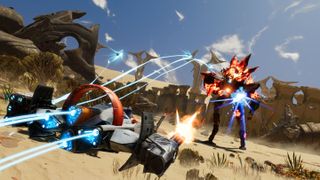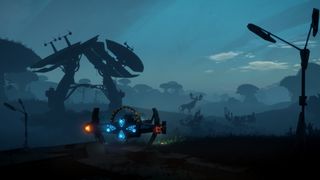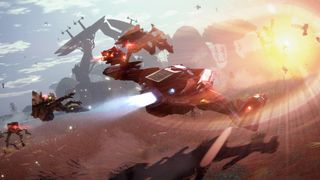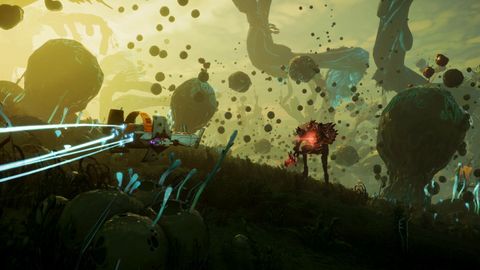
Starlink: Battle for Atlas is an open-world shooter brimming with potential. The title can be played digitally, or through the use of figurines like those found in Disney Infinity and Skylanders. The toys-to-life approach hinders its potential at a grander scale because, at times, it feels like the game was pared down to appeal to a younger demographic. Instead of mature characters, Starlink features bizarre teenagers who joke around despite the fact that their lives are in peril. The title could've been a franchise to rival the greatest sci-fi series' out there due to its expansive environments. Indeed, Starlink is excellent, but it could've been one of the best games of 2018 if Ubisoft had taken a few more risks.
Gameplay and inspirations
Starlink takes a lot of cues from experiences like Mass Effect: Andromeda and No Man's Sky. Just like Mass Effect: Andromeda, the latest adventure from Ubisoft starts off with a crash landing and a missing captain. The eventual goal is to recruit allies to defeat an oppressive force known as the "Legion." While the shooting can feel repetitive, there are a lot of activities to partake in on each planet. Certain zones feature higher-tiered enemies, so you have to return to these areas once you're strong enough. You can mine resources, harvest plants, explore ruins, research animals, and participate in other sorts of activities to grow your character.
Gameplay is a lot more like No Man's Sky however.
The gameplay resembles No Man's Sky in some ways. However, unlike No Man's Sky, you can't exit your craft, and have to pick up missions and fight on land from your ship. The inability to jump out of your ship and explore your immediate surroundings feels like a missed opportunity. Even though you're exploring uncharted space, you feel trapped in Starlink. Instead of providing a rover or some other land-based vehicle, Starlink essentially turns your spaceship into a hovercraft. You even have to "jump" to avoid incoming fire. It feels jarring, almost as if developer Ubisoft Toronto ran out of time and decided to cut some features.
Visuals and performance

Starlink seems to run at 4K resolution on Xbox One X, but the frame rate is locked to 30 FPS. It typically maintains its frame rate, aside from when there are a lot of enemies or explosions on screen. Since the game doesn't appear to be too technically demanding given its visuals, a 60 FPS mode is a strange omission. Starlink features gorgeous lighting, but the ground textures are muddy and lacking in detail. Aside from the boost to the resolution, it doesn't seem like Ubisoft Toronto put much work into taking full advantage of the Xbox One X or PlayStation 4 Pro. The game looks eerily similar to the one found on Nintendo Switch. It's evident that not a lot of effort was put into enhancing it for the more powerful consoles.
The game was designed for the Nintendo Switch.
The Nintendo Switch version features Star Fox, who has his own backstory. The Xbox One and PlayStation 4 versions feature no such additional characters. As such, it can feel as if the game was designed for the Nintendo Switch and the other versions were an afterthought. Why couldn't the Xbox One version get a guest character from a Microsoft franchise? It comes across as an unfair omission, especially considering the breadth of additional content available on the Nintendo Switch at no added cost. While marketing agreements are an integral part of the gaming industry, publishers should still aim for content parity.
Toys-to-life approach

Starlink's toys are of the highest quality. The plastics are smooth, and each piece fits into its designated slots perfectly. You have to use a holster to attach the toys to your controller. Unfortunately, they're a little awkward to attach to an Xbox One controller, and some of the larger ships hinder your ability to use thumbsticks or buttons comfortably. They're also quite challenging to take apart once a pilot has been inserted into the cockpit.
They toys are quite difficult to take apart once a pilot has been inserted.
The toys are great collectibles, but if you want to play the game without getting slaughtered by powerful enemies, you'll want to go with the Digital Deluxe Edition. It comes with all of the spaceships, and you don't have to fumble around when you're trying to change weapons, vehicles, or pilots.
Unbelievable customization

Customization plays a major role in Starlink. You can modify the way your ship looks and the capabilities of various weapons. For example, you can rear mount your guns during interstellar combat.
Ship customization plays a major role in Starlink.
Certain additional ship parts increase your offense or defense. Apart from that, you can equip mods which can make you even stronger. Learning how all of these mechanics work is an important step towards mastering the game and makes for rewarding play over time.
Smooth gameplay

Starlink is a lot of fun to play, and even though it's locked to 30 FPS, the combat feels smooth and responsive. Given the upgrade systems, gameplay can be quite complex as well, because you have to customize your loadout depending on the threat you're about to tackle. Using a standard Gatling gun on an enemy that's only vulnerable to ice weaponry won't do you much good. Before entering into certain combat scenarios, you have to scrutinize your opponents. Equipping the right arsenal is essential to success.
The combat feels smooth and responsive.
Maneuvering your ship is also an absolute joy. Whether you're hovering above a planet's surface or taking out pirates in the vacuum of space, the controls never let you down. There's absolutely no learning curve and anyone can pick it up immediately. The controls seem to be designed for all age groups in mind.
Starlink: Battle for Atlas final thoughts

Overall, Starlink is an impressive experience. It's a shame that the story and limited exploration options hold the title back. The game could've rivaled some of the best space exploration games out there, but its need to appeal to a younger crowd undoubtedly takes away from the package. More than anything, Starlink needs a stronger cast of characters, and the ability to explore your immediate surrounding on foot and interact with the game's worlds directly. Despite these issues, the game is a lot of fun, especially when you're blasting away enemies in thrilling space combat. I just wish its true potential had been realized.
Pros:
- Massive open-world environments.
- Tight controls.
- Detailed customization.
- Weapon variety.
Cons:
- Weak characters.
- Can't exit craft.
- Expensive toys.
- Poor Xbox One X support.
Starlink: Battle for Atlas is currently available on Xbox One, Nintendo Switch, and PlayStation 4. Pricing starts at $59.99.
Keep an eye on WindowsCentral.com/Gaming for all the latest in Xbox and Windows 10 gaming, accessories, news, and reviews!
This review was conducted on an Xbox One X and PlayStation 4 Pro, using a copy provided by the publisher and purchased by the author.
Asher Madan handles gaming news for Windows Central. Before joining Windows Central in 2017, Asher worked for a number of different gaming outlets. He has a background in medical science and is passionate about all forms of entertainment, cooking, and antiquing.

